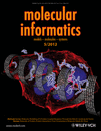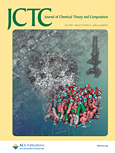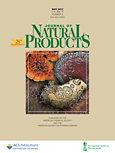
Molecular Informatics
Scope & Guideline
Unlocking Insights Through Molecular Modeling
Introduction
Aims and Scopes
- Computational Drug Discovery:
The journal extensively covers methodologies related to the computational identification and optimization of drug candidates, including virtual screening, molecular docking, and pharmacophore modeling. - Cheminformatics and Data Science:
Research in this area focuses on the application of data science techniques to chemical data, including the development of predictive models using machine learning and statistical methods. - Molecular Modeling and Simulation:
The journal publishes studies employing molecular dynamics simulations, quantum chemical calculations, and other modeling techniques to understand molecular interactions and dynamics. - Toxicology and ADMET Studies:
There is a strong emphasis on the prediction of absorption, distribution, metabolism, excretion, and toxicity (ADMET) properties of compounds, which is crucial for drug development. - Natural Product Informatics:
Research highlighting the role of natural products in drug discovery and their computational analysis is a significant aspect, including the exploration of chemical space related to natural compounds.
Trending and Emerging
- Machine Learning and AI Applications:
There is a significant rise in the use of artificial intelligence and machine learning techniques for predictive modeling, data analysis, and drug discovery processes, showcasing the integration of advanced computational methods. - Integrated Approaches for Drug Repurposing:
Emerging studies are increasingly focusing on drug repurposing strategies, utilizing network-based approaches and computational tools to identify new uses for existing drugs, particularly in response to global health challenges. - Interdisciplinary Research:
Research that combines insights from various fields such as bioinformatics, chemoinformatics, and systems biology is gaining traction, promoting a holistic view of molecular interactions and drug development. - Natural Product-Based Drug Discovery:
There is a resurgence of interest in natural products, with studies exploring their potential as sources for new drug candidates through computational methodologies, reflecting a trend towards sustainable and bio-inspired drug design.
Declining or Waning
- Traditional QSAR Models:
While quantitative structure-activity relationship (QSAR) models remain important, there is a noticeable decline in traditional approaches, with a shift towards more advanced machine learning techniques that enhance predictive capabilities. - Basic Molecular Docking Studies:
Research focused solely on molecular docking without integration of other computational methods (like dynamics simulations or machine learning) is becoming less frequent, as more comprehensive approaches are favored. - Single-Target Drug Discovery:
The trend is moving towards multi-target and polypharmacology strategies, leading to a decrease in studies that focus exclusively on single-target drug discovery approaches.
Similar Journals

JOURNAL OF MOLECULAR GRAPHICS & MODELLING
Advancing Knowledge Through Molecular ModelingJOURNAL OF MOLECULAR GRAPHICS & MODELLING, published by Elsevier Science Inc, is a leading peer-reviewed journal dedicated to the fields of molecular graphics and modeling. With an ISSN of 1093-3263 and an E-ISSN of 1873-4243, this journal has established its relevance since its inception in 1997, and continues to thrive as it extends its scope into 2024. Acknowledged for its impact in the academic community, it holds a Q2 ranking in both Computer Graphics and Computer-Aided Design and Materials Chemistry, as well as a Q3 ranking in Physical and Theoretical Chemistry and Spectroscopy, reflecting its significance across multidisciplinary research domains. Notably, the journal ranks in the 73rd percentile for Computer Graphics and maintains competitive standings in Materials Science and Chemistry areas. Although it does not currently offer open access options, the journal is an essential resource for researchers, professionals, and students who are engaged in cutting-edge studies and applications in molecular graphics, computational methods, and material design. By facilitating a deeper understanding of molecular interactions through innovative graphical modeling, the journal contributes significantly to advancements in science and technology.

SAR AND QSAR IN ENVIRONMENTAL RESEARCH
Advancing Environmental Insights through Molecular Relationships.SAR and QSAR in Environmental Research is a leading journal published by Taylor & Francis Ltd, focusing on the integration of Structure-Activity Relationships (SAR) and Quantitative Structure-Activity Relationships (QSAR) within the realm of environmental science. Since its inception in 1993, the journal has been a pivotal platform for disseminating innovative research that bridges the gap between chemistry and environmental sustainability, ranking in the Q3 quartile for Bioengineering, Drug Discovery, and miscellaneous Medicine categories as of 2023. Featuring a compelling collection of peer-reviewed articles, it caters to academic and professional audiences seeking to enhance their understanding of molecular interactions and their implications for environmental health. Although the journal does not currently offer Open Access options, its rigorous editorial standards ensure high-quality, impactful publications that are crucial for advancing methodologies in pharmacology, toxicology, and bioengineering. With an ISSN of 1062-936X and an E-ISSN of 1029-046X, SAR and QSAR in Environmental Research continues to serve as an essential resource for researchers, academics, and practitioners dedicated to innovative approaches in environmental research.

JOURNAL OF COMPUTER-AIDED MOLECULAR DESIGN
Innovating Drug Discovery through Computational MasteryJOURNAL OF COMPUTER-AIDED MOLECULAR DESIGN, published by Springer, serves as a premier platform for researchers in the fields of computer science applications, drug discovery, and physical and theoretical chemistry. Since its inception in 1987, the journal has played a pivotal role in advancing the methodologies and technologies used in molecular design and screening. With an impressive impact factor and a ranking within the top quartile across related disciplines, this journal offers invaluable insights and innovative approaches that are essential for scholars and practitioners in these dynamic fields. The journal's rigorous peer-review process ensures high-quality publications that contribute significantly to both theoretical and practical advancements. Though it operates under a subscription model, the journal remains dedicated to fostering knowledge dissemination and collaboration among researchers.

Wiley Interdisciplinary Reviews-Computational Molecular Science
Catalyzing Interdisciplinary Dialogue in Molecular ResearchWiley Interdisciplinary Reviews: Computational Molecular Science is a premier journal published by WILEY, dedicated to the intersection of computational techniques and molecular science. Boasting an impressive impact factor and consistently ranking in the Q1 category across several key disciplines including Biochemistry, Computational Mathematics, Computer Science Applications, Materials Chemistry, and Physical and Theoretical Chemistry, this journal plays a crucial role in disseminating high-quality research that bridges multiple fields. With its focus on providing a platform for interdisciplinary dialogue and innovative computational solutions, it serves as an essential resource for researchers, professionals, and students eager to push the boundaries of molecular science. While the journal does not currently offer open access, it remains a vital conduit for scholarly communication, fostering advancements in understanding molecular interactions through computational methods. The journal is based in the United States, contributing to its global outreach and impact in the scientific community.

Peptide Science
Advancing peptide knowledge for a transformative future.Peptide Science, published by Wiley, is an esteemed journal dedicated to advancing the understanding of peptide chemistry and its applications across various scientific disciplines, including biochemistry, biophysics, and organic chemistry. Since its inception in 2018 and continuing through 2024, this journal has provided an essential platform for the dissemination of innovative research, engaging articles, and critical reviews. With an impressive Q3 ranking in the fields of Biochemistry and Biomaterials, and a Q2 status in Biophysics and Organic Chemistry as of 2023, Peptide Science acknowledges its integral role in addressing significant scientific challenges. This open-access journal ensures that findings are readily available to a global audience, fostering collaboration and knowledge sharing among researchers, professionals, and students alike. The journal exemplifies excellence in scholarly communication, making it an essential resource for anyone interested in the intricate world of peptide research.

Quantitative Biology
Transforming Biological Research with Mathematical PrecisionQuantitative Biology is a prestigious journal published by WILEY, focusing on the interdisciplinary study of quantitative approaches in the biological sciences. With an ISSN of 2095-4689 and an E-ISSN of 2095-4697, this journal has established itself as a critical platform for researchers exploring complex biological systems through mathematical and computational methodologies. Operating out of China, Quantitative Biology significantly contributes to its field, holding a Q2 ranking in various categories, including Applied Mathematics and Biochemistry, Genetics and Molecular Biology, according to the latest Scopus rankings. These rankings reflect the journal's commitment to publishing high-quality research that employs advanced modeling and simulation techniques. The journal's impact is evident with its position in the 84th percentile for Applied Mathematics, indicating its relevance and growth in a competitive academic landscape. Although it does not currently operate under an Open Access model, the journal is pivotal for professionals and students alike, aiming to bridge the gap between mathematical theories and biological applications. Researchers are encouraged to submit their innovative findings and engage with the vibrant community dedicated to advancing the quantitative understanding of biological phenomena.

Current Research in Structural Biology
Unveiling Molecular Mysteries, One Study at a TimeCurrent Research in Structural Biology, published by Elsevier, is a pioneering Open Access journal that has rapidly gained prominence since its inception in 2019. With a focus on advancing the understanding of molecular and structural biology, this journal provides a platform for researchers and professionals to publish groundbreaking findings that contribute to the field's ongoing development. With a commendable Q2 ranking in both Molecular Biology and Structural Biology categories for 2023, it serves as a vital resource for the community, ensuring accessibility to high-quality research. The journal is indexed in Scopus, showcasing its significant impact and relevance, particularly with a ranking of #26/49 in the Structural Biology discipline. Located in the heart of the Netherlands, Current Research in Structural Biology not only fosters academic discourse but also encourages collaborative research efforts in addressing critical biological questions. Whether you are a researcher, student, or industry professional, this journal is essential for staying abreast of the latest advancements and trends in structural biology.

Journal of Chemical Theory and Computation
Catalyzing Progress in Computational TechniquesThe Journal of Chemical Theory and Computation, published by the American Chemical Society, stands at the forefront of the multidisciplinary fields of computational chemistry and computer science applications. With an impressive impact factor and ranking in the top quartile (Q1) in both Physical and Theoretical Chemistry and Computer Science Applications, this journal serves as a vital platform for researchers and professionals seeking to publish cutting-edge research on computational methodologies and innovative theoretical approaches. Spanning from 2005 to 2024, the journal aims to disseminate high-quality studies that advance understanding of molecular systems and the development of computational techniques. Its esteemed reputation is reflected in its robust metrics, ranking #23 in Physical and Theoretical Chemistry and #101 in Computer Science Applications by Scopus, showcasing its significant influence in the academic community. While it does not currently offer open access, the journal remains accessible to a wide audience, making it an essential resource for those engaged in the evolving landscape of chemical theory and computation.

JOURNAL OF NATURAL PRODUCTS
Harnessing Nature's Wisdom for Modern ScienceJOURNAL OF NATURAL PRODUCTS, published by the American Chemical Society, is a premier academic journal that focuses on the study and application of natural products in various scientific domains. With an esteemed ISSN of 0163-3864 and an E-ISSN of 1520-6025, this journal caters to a wide range of fields, including Analytical Chemistry, Complementary and Alternative Medicine, Drug Discovery, Molecular Medicine, Organic Chemistry, Pharmaceutical Science, and Pharmacology. The journal consistently ranks in the Q1 and Q2 quartiles across these categories, reflecting its significant contribution and rigorous standards in the scientific community. Notably, its Scopus rankings highlight its influence, with notable percentiles across various fields, including a 93rd percentile in Complementary and Alternative Medicine. The JOURNAL OF NATURAL PRODUCTS aims to advance knowledge in the field by publishing groundbreaking research articles, reviews, and critical insights, making it an essential resource for researchers, professionals, and students dedicated to exploring the vast potential of natural substances. This journal addresses complex challenges and fosters innovative developments, further establishing its place as a cornerstone in natural products research. Access to published articles may vary, underscoring the need for individuals in this field to stay connected with the latest advances through the journal's offerings.

Journal of Computational Biophysics and Chemistry
Innovating Computational Techniques for Biochemical BreakthroughsThe Journal of Computational Biophysics and Chemistry, published by World Scientific Publishing Co. Pte Ltd, is a distinguished platform dedicated to advancing the fields of biophysics and computational chemistry. With an ISSN of 2737-4165 and an E-ISSN of 2737-4173, this journal has garnered attention since its inception, earning a Q3 ranking in Computational Theory and Mathematics and Q4 rankings in both Computer Science Applications and Physical and Theoretical Chemistry as of 2023. The scope of the journal encompasses innovative research that integrates computational techniques with biochemical applications, making it essential reading for researchers, professionals, and students alike. With open access options available, the journal ensures that cutting-edge findings are easily accessible to a global audience, thereby fostering collaboration and innovation in the scientific community. Based in Singapore, the journal aims to converge ideas and methodologies from 2021 to 2024, paving the way for transformative insights in computational methods. Join a community at the forefront of research and applications that bridge disciplines through rigorous scholarship and pioneering discoveries.